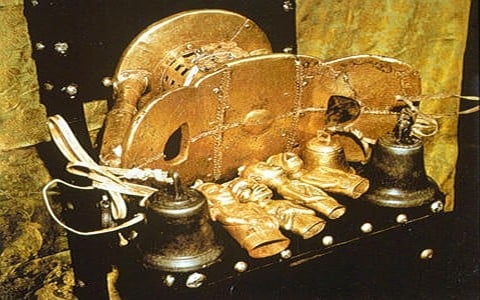Error: In this episode I claimed that the Adansi were the dominant people in the kingdom of Twifo. This is not true, no idea why I said this. The kingdom was dominated by the Twifo people. Might have been a typo in the script.
Hello everyone, I hope you enjoy listening to the first episode of the third season of the history of Africa podcast. With our exploration of Aksum concluded, we can move onto our coverage of the Ashanti Empire, a fascinating state that dominated the Ghanaian forest region throughout the early modern period. However, before we dive into the history of the Ashanti Empire, we must first understand the cultural, historical, and economic contexts that led to the empire's rise in the first place.
Despite being located on the continent that birthed humanity, human settlement in West Africa may have come later than you might expect. Homo Sapiens arrived in West Africa around the same time as the earliest migrations off the continent, and, of course, initially lived as hunter gatherers. The region experienced an agricultural revolution around 3000 BC, giving rise to the Kintampo Culture. This neolithic culture, likely initiated by migrants from the savanna region to the north, established the first agrarian settlements. However, the Ghanaian forest region would remain incredibly sparsely populated for the next 4000 years.

Starting around 1000 AD, Ghana experienced waves of migration from outside. The first arrivals were the Guang, sometimes called the Guan. The Guang established the first major settlements in Ghana, essentially the first true states. While the government and culture of these early Guang settlements is largely a mystery, the traditions of later arrivals indicate that, at least the northernmost Guan cities, were ruled primarily by a theocratic class of Tindanas (Earth Priests).
The next peoples to arrive in Ghana were the Dagomba and Akan, who arrived roughly during the same time period (estimates range from the 12th to 14th centuries.) The Dagomba, a Muslim ethnic group from the Lake Chad region, set up several independent kingdoms, before they were united into the Empire of Dagbon in the far north of Ghana. The Akan, the group which this podcast will primarily focus on, migrated into Western Ghana from the western Sahel. This region, marked by immense political instability due to the collapse of the Empire of Ouagadou (often called the Empire of Ghana today, but not to be confused with the largely unrelated modern region), was increasingly embracing the faith of Islam. The Akan, staunchly attached to their practice of the traditional faith, which we'll learn more about in future episodes, fled into the forests of Ghana. There, they established a new state at the site of Bono Manso. This city, strategically located on a trade route of gold and salt, established itself not only as an important trade middleman, but also as a center of crafts, pottery, and toolmaking. This wealth allowed the Bono State to expand its influence, and many Akan migrated further South. However, these migrating Akan would not remain culturally united. As they migrated further apart from each other, the dense forests ensured that communication between Akan settlements was sporadic, and as a result different Akan settlements produced significantly different cultures. So, while the Akan would continue to share many cultural traits with each other, such as a shared language and a mostly shared religion, certain aspects of inheritance, politics, and material culture would vary by region. These early splits would eventually manifest in the creation of multiple distinct Akan sub-cultures, including Denkyira, Akwamu, Adansi (Akyem), Kwahu, Fante, and, of course, the Ashanti. Eventually, in the cases of Denkyira, Akwamu, and Adansi, these cultures would soon form the basis of united kingdoms by the end of the 15th century. Finally, a group of people called the Gadangme migrated into southeast Ghana, where they would establish several independent city states of their own, including the major city of Accra.
Error: In the episode I claim that the Ga-Dangme migrated from the region around Lake Chad. There is substantially more debate around this than I imply, and I meant to say that Ga-Dangme traditional history states that they come from Lake Chad. Most modern anthropologists argue for a more local origin North of the Volta River or in northern Nigeria.

The establishment of Bono Manso and the Akan migrations forever changed the economy of West Africa. Prior to the establishment of Bono Manso, the forest region of Ghana was a relatively destitute backwater. The region's economy was dominated almost exclusively by gold panning. This gold would be traded primarily for salt and finished goods to the states of the Sahel and Savanna, who would in turn pedal the gold from the forest to merchants in the North for a profit. While this system was incredibly advantageous to the Sahelian and Savanna states that could act as trade middlemen, it was incredibly disadvantageous to the people of the forest region and the North. Due to Sahelian taxes on traded goods, any goods sold by either side would see a portion of its value siphoned, and, to compensate, any sale of salt or gold in West Africa was at a slightly inflated price. However, the establishment of Bono Manso radically changed this system. For starters, the establishment of a manufacturing center for finished goods ensured that the forest region was no longer dependent on the north for these goods. Additionally, the city's strategic location allowed Bono Manso to act as a middleman between the forest and the Sahel, allowing it to benefit from the siphoning of value for trade.
 |
| Map of West African climate zones |
This system would remain disadvantageous to the people in the far south, however, until the introduction of a new group of people would radically alter the economics of West Africa further. When European merchants offer a new avenue to sell gold and...other products to the outside world while avoiding Bonoman or Sahelian taxes, the forest region will never be the same. In this new economic status quo, the city of Jukwaa and its Denkyira inhabitants will benefit immensely, and become the first true empire in the history of southern Ghana.





















